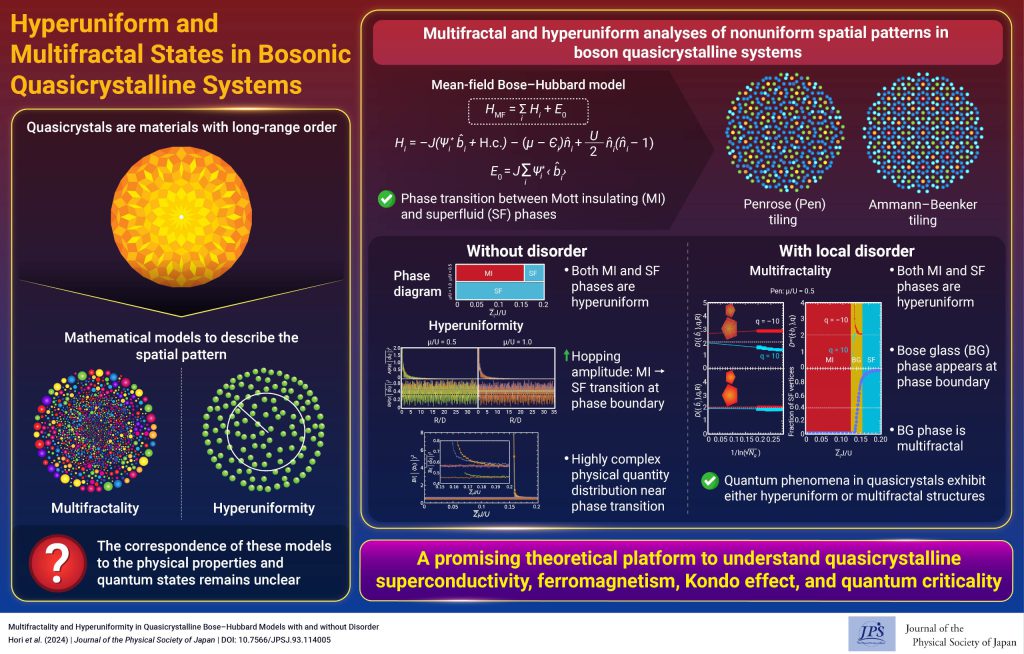Hyperuniform and Multifractal States in Bosonic Quasicrystalline Systems
© The Physical Society of Japan
This article is on
Multifractality and Hyperuniformity in Quasicrystalline Bose-Hubbard Models with and without Disorder
(JPSJ Editors' Choice)
J. Phys. Soc. Jpn.
93,
114005
(2024)
.
Quantum states can be categorized as hyperuniform or multifractal based on electronic characteristics. This study demonstrates that bosonic quasicrystalline systems exhibit hyperuniform or multifractal quantum states.

The atomic arrangement of materials significantly influences their physical properties, requiring precise analysis of these structures. Atomic arrangements are classified into crystals, amorphous solids, and quasicrystals. The crystal exhibits periodic atomic patterns, while amorphous solids are characterized by disordered arrangements. However, quasicrystals lack periodicity but exhibit long-range order.
Multifractality and hyperuniformity are two mathematical frameworks used to characterize the spatial patterns of atomic arrangements. The atomic structure of quasicrystals demonstrates multifractal properties, often referred to as self-similarity, while their global structure exhibits hyperuniformity. Fractal atomic arrangements are typically associated with disordered systems, such as amorphous solids, while uniformity characterizes periodic structures like crystals. The coexistence of these features in quasicrystals raises fundamental questions regarding their physical properties and quantum states.
Recent experimental advancements have developed bosonic quasicrystalline systems using ultracold atoms, motivating further theoretical analysis. This study employed the Bose-Hubbard model, which describes a phase transition between Mott insulating and superfluid phases. Introducing local disorders, such as impurities, at the phase boundary leads to a novel quantum phase termed Bose glass. Hyperuniform and multifractal analyses were applied to investigate the characteristics of these phases, their transitions, and their differences from periodic systems.
Both the Mott insulating and superfluid phases exhibited hyperuniformity without local disorder. Increasing the hopping amplitude (the probability of bosons transitioning between atomic sites) induced a phase transition from the Mott insulating to the superfluid phase. A substantial increase in the complexity of physical quantity distributions was observed near the phase transition in quasicrystals, a phenomenon not present in crystals.
The Mott insulating and superfluid phases maintained their hyperuniformity in local disorder, while the Bose glass phase exhibited multifractal characteristics. These findings indicate that quantum states in quasicrystals can manifest as either hyperuniform or multifractal structures depending on the phase and disorder.
The results provide a theoretical foundation for understanding quasicrystalline phenomena, including superconductivity, ferromagnetism, the Kondo effect, and quantum criticality. Hyperuniformity-based analyses have been applied across physics, life sciences, astronomy, and mathematics. Extending such analyses to quasicrystalline systems could enable the quantitative characterization of spatial patterns. This study aims to contribute to identifying novel quasicrystalline properties with potential applications that benefit humanity.
(Written by Masahiro Hori on behalf of all the authors)
Multifractality and Hyperuniformity in Quasicrystalline Bose-Hubbard Models with and without Disorder
(JPSJ Editors' Choice)
J. Phys. Soc. Jpn.
93,
114005
(2024)
.
Share this topic
Fields
Related Articles
-
Qualitative Changes in Kinetic Pathways Driven by Hydrodynamic Interactions in Dense Colloidal Suspensions
Cross-disciplinary physics and related areas of science and technology
Statistical physics and thermodynamics
Structure and mechanical and thermal properties in condensed matter
2025-4-18
Even in dense colloidal suspensions, where long-range hydrodynamic interactions are screened, near-field hydrodynamic interactions qualitatively influence the selection of kinetic pathways.
-
Overcoming Phase Transitions for Faster Quantum Annealing
Statistical physics and thermodynamics
2025-3-27
This study presents an innovative method to address the problem of phase transitions in quantum annealing, resulting in an exponential speedup of the process.
-
Exploring the Vibrant Interplay of Machine Learning and Physics
Cross-disciplinary physics and related areas of science and technology
Electron states in condensed matter
Elementary particles, fields, and strings
Mathematical methods, classical and quantum physics, relativity, gravitation, numerical simulation, computational modeling
Statistical physics and thermodynamics
Superconductivity
2025-3-13
This Journal of the Physical Society of Japan Special Topics edition explores how physics and machine learning complement each other and can solve unresolved problems in physics.
-
Bayesian Insights into X-ray Laue Oscillations: Quantitative Surface Roughness and Noise Modeling
Measurement, instrumentation, and techniques
Structure and mechanical and thermal properties in condensed matter
2025-2-14
This study adopts Bayesian inference using the replica exchange Monte Carlo method to accurately estimate thin-film properties from X-ray Laue oscillation data, enabling quantitative analysis and appropriate noise modeling.
-
Spin-Spin Interaction Mediated by Rotational Lattice Vibrations
Magnetic properties in condensed matter
Structure and mechanical and thermal properties in condensed matter
2025-1-24
This study predicts the presence of spin-spin interactions mediated by the angular momentum of lattice vibrations, which can be long-range.




